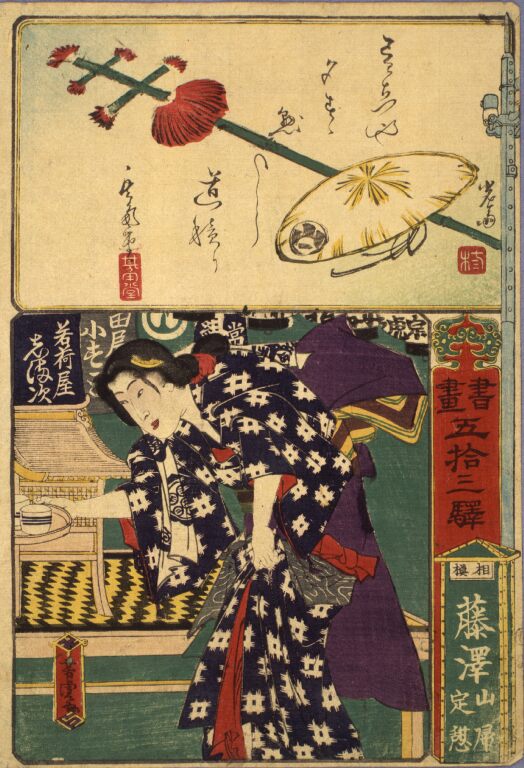資料名 |
Fujisawa of Sagami Province: Yamagaeri-joukei, from the series Fifty-three Stations of the Toukaidou with Assorted Shoga (calligraphy of famous verses and pictures in sets) |
解説 |
Utagawa Yoshitora 1872 In this series, the set of writings and pictures by famous writers and artists are illustrated on the upper part and the historical events, folklores, landscapes and customs related to the stations are illustrated on the lower part. For Fujisawa station, Kikakudou, a poet Hozumi Eiki’s (1823-1904) haiku poetry is illustrated on the upper part. For the lower part, a waitress serving teas at a rest-shop for the pilgrims who returned from Mt. Oyama is illustrated. The title Yamagaeri (Return from a mountain)’s “yama” indicates the Mt. Oyama and this mountain was also known as “Rainy Mountain (Amefuri-yama ”. The shrine shape wooden container on the table behind the waitress is “omiki-waku”, a liquor or water container that signifies the pilgrimage to Mt. Oyama. The pole illustrated at the right edge on the frame is an electric pole that was situated around that time. This electric pole is drawn in the each picture, symbolizes the street of modern Meiji period. Utagawa Yoshitora Date of birth and death unknown Yoshitora was a pupil of Utagawa Kuniyoshi and active during Tempo era to Meiji 20’s (1830~1887). His fortes were warrior and battle pictures and produced numerous Yokohama-e (ukiyo-e depicting foreigner’s life style and the scenes of Yokohama) and motifs related to the Seinan Senso (the Satsuma Rebellion). He was a representative Utagawa school ukiyo-e artist, with Yoshiiku and Yoshikazu, but it is said that he had a fight with his teacher and eventually expelled from the school. |
資料番号 |
10637 |







